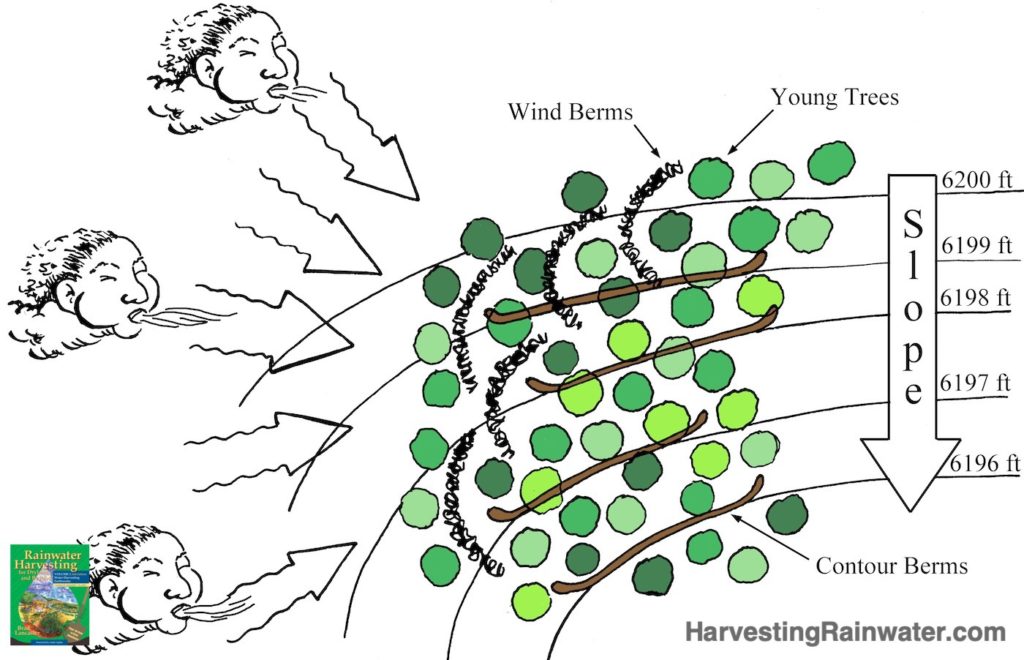Snow & wind harvesting case study
Snow & wind harvesting case study
Latitude 35˚N. Elevation 6,200 feet (1,890 meters)
Moriarty, New Mexico, USA
Average annual rainfall 14 inches (355 mm).
Average annual snowfall 25 inches (635 mm)
The following is excerpted and adapted from a case study by Chris Meuli in Rainwater Harvesting for Drylands and Beyond, Volume 2, 2nd Edition…
During a severe drought in 1996 with numerous wildfires occurring, Chris Meuli decided to reduce the fire risk on his semirural property in Edgewood, New Mexico by thinning pinyon pine and juniper trees that were crowded, diseased, or too close to buildings.
Then he asked himself, “Where can I use this biomass that I’ve thinned with the least amount of work for the greatest benefit?”
Nearby, on the windswept, treeless high plains desert near Moriarty, New Mexico, Chris had been working for over a decade to establish windbreaks.
But the versatile honey locusts he planted in the 1980s had stopped growing vertically and started growing horizontally in the persistent wind of this site. More recent plantings of hardier evergreens paired with contour berms were faring better, but to improve success, the drying effect of the harsh wind needed to be addressed.
So, Chris hauled the thinnings (“slash”) from Edgewood over to Moriarty to construct windberms for the young windbreak trees. Windberms are built structures that serve the same purpose as traditional windbreaks, which are typically “grown.” The idea
was to slow the wind down, deflect it off the ground, and attenuate its strong mechanical forces. Perhaps the windberms would also harvest moisture during the blowing winter snows.
At this 20-acre (8-ha) site a relentless westerly wind blows virtually parallel to the contour, and annual precipitation averages 14.5 inches or 368 mm at an elevation of 6,217 feet or 1,894 m. During most days, the wind is a constant 5 to 15 miles (8–24 km) per hour with regular gusts to 15 to 45 miles (24–72 km) per hour in the spring. By feeling, hearing, and seeing the patterns of blowing sand and debris, Chris knew that the wind direction varied 30–45 degrees from moment to moment. Windberms curved with their “backs” into the wind, so to speak, could address this constant variation.
Based on traditional windbreak design, windberms should be semipermeable so that they can filter and slow the wind. In contrast, a solid wall of material can cause scouring and actually amplify wind effects. A windbreak will calm the wind to a distance 3 to 5 times the height of the windbreak on the windward side and to a distance 10 to 15 times the height of the windbreak on the leeward side. Berms can be placed to complement or alter the existing patterns created by water flows, roads, fences, structures, windbreaks, and human and animal paths.
Fifteen pick-up loads of slash were sufficient to construct five windberms, each 3–4 feet (0.9–1.2 m) high and 40–120 feet (12–36 m) long. Stacked in interlocking patterns, the slash did not blow apart in gusts of wind. Overlapping the ends of the windberms prevented wind from funneling between two adjacent windberms while allowing room for walking and pulling a cart between them.

By the end of the summer, the slash had dropped most of its needles, mulching the ground beneath it and adding much-needed organic matter to this recovering former cattle range. The berms also enhanced the habitat for reptiles and small mammals.
The effect that the windberms had on a snowfall the following January was dramatic. Severe winds blew the 16 inches (40 cm) of snow off of his neighbors’ land into drifts that were 2 to 3 feet (0.6–0.9 m) deep on both the windward and lee sides of the windberms.

Two years later, there is a dramatic increase in the size and health of the trees on both sides of the windberms compared to trees further away. A great diversity of vigorous groundcover and grass has grown up in and alongside the berms. These enhance the wind-modifying, shading, mulching, and water-retention effects.
For more information
See these award-winning books available at deep discount direct from the author…

Volume 1
In Volume 1see appendix 8: Wind Harvesting: Basic Airflow Relationships, Site Selection, Wind Pumping and Wind Power, Natural Ventilation, Windbreaks, and Snow- and Biomass-Drift Harvesting

Volume 2
In Volume 2 see the Harvesting Windswept Snow case study in chapter 3 and Snow Diversion Berms case study in chapter 9
